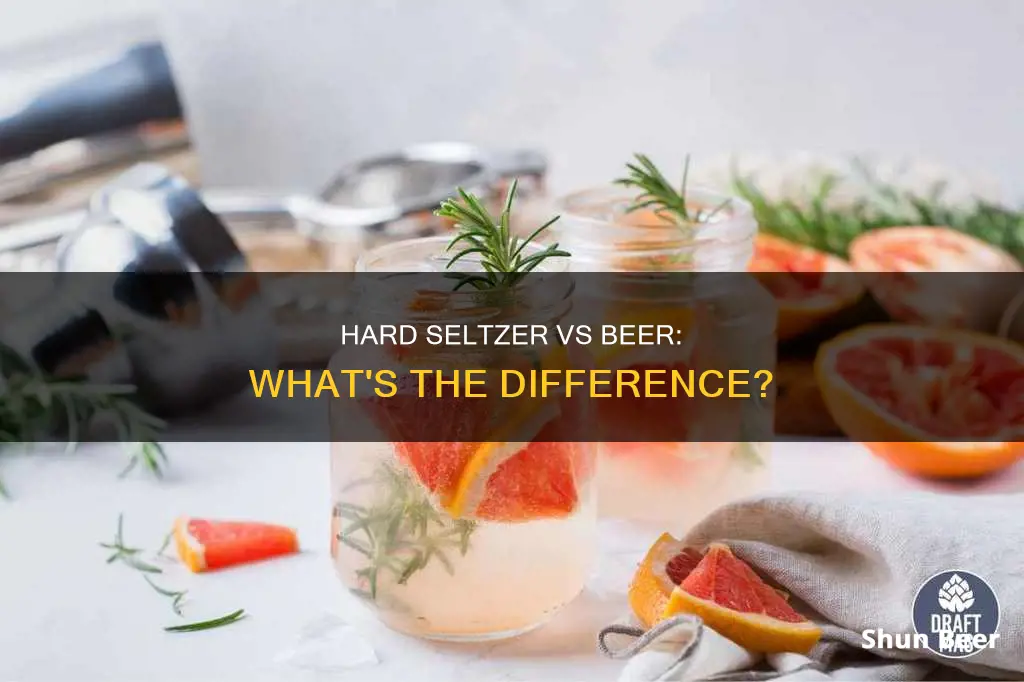
Hard seltzer and beer are both alcoholic beverages that are brewed and fermented using a sugar source. However, the key difference lies in the fermentation process and the resulting flavour profiles. Beer is typically made by fermenting malted grains, such as barley or wheat, which are mashed into hot water to create wort. The wort is then boiled, cooled, and hops are added before yeast is introduced to start the fermentation process. Beer often has a slightly bitter and malty taste. On the other hand, hard seltzer is produced by fermenting pure sugar sources, such as cane sugar or agave syrup, directly in water. This results in a clear, flavourless alcohol base that can be infused with natural or artificial flavourings, typically giving it a fruity taste. Hard seltzer usually has a lower calorie count and is gluten-free, making it a popular alternative for health-conscious consumers.
What You'll Learn

Fermentation process
The main difference between hard seltzer and beer is what is being fermented. In the case of beer, malted grains are mashed in to make wort, which is then boiled and cooled before yeast is added. The yeast then ferments the sugars in the wort to produce alcohol and carbon dioxide. The fermentation process for beer typically takes about two weeks for ales (maintained at a constant temperature of 68°F or 20°C) and about six weeks for lagers (maintained at 48°F or 9°C).
On the other hand, hard seltzer is made by fermenting sugar in water. This process also involves the addition of yeast to convert sugar into alcohol. However, hard seltzer fermentation differs from beer fermentation in that it starts with a clear, flavourless, and colourless solution due to the absence of grains. The fermentation process for hard seltzer can be challenging due to the low nutrient content of sugar-based ferments, and it may require supplementation with nutrients like nitrogen, vitamins, and minerals to promote healthy yeast growth and survival.
The fermentation process for both beer and hard seltzer involves combining a specific type of sugar with yeast to produce alcohol. However, the key difference lies in the source of sugar being fermented, which is malted grains for beer and sugar in water for hard seltzer.
The fermentation process for beer begins with the preparation of wort, which involves mashing in malted grains to extract sugars. The wort is then boiled, cooled, and combined with yeast to initiate fermentation. During fermentation, the yeast converts the sugars in the wort into alcohol and carbon dioxide. The specific gravity of the mixture is measured at the beginning and may be measured again to determine the alcohol content and when to stop fermentation.
For hard seltzer, the initial step is to create a sugar solution by combining sugar and water. This solution may be adjusted for pH and yeast nutrients. The sugar wash is then boiled and cooled before yeast is added to start the fermentation process. Similar to beer, the yeast in hard seltzer fermentation converts sugar into alcohol. However, the fermentation process for hard seltzer can be more unpredictable and slow compared to beer due to the lack of nutrients in sugar-based ferments.
To address the challenges of sugar fermentation in hard seltzer production, supplementation with nutrients is essential. Nitrogen, as assimilable nitrogen or free amino nitrogen, is particularly crucial for yeast health and reproduction. Other nutrients such as vitamins, minerals, and survival factors are also important for optimal yeast performance during fermentation. By providing the necessary nutrients, producers can decrease fermentation time and promote complete fermentation.
Additionally, the choice of yeast strain and dosage plays a significant role in hard seltzer fermentation. Different yeast strains have varying traits, including alcohol tolerance, nutrient requirement, temperature tolerance, ability to breakdown disaccharides, fermentation speed, and many other traits. Selecting a suitable yeast strain, such as VI-A-DRY BOSS™ yeast, that can withstand the specific fermentation conditions is vital for a successful fermentation.
The fermentation temperature also impacts the outcome of the process. While warmer temperatures accelerate fermentation, they can also increase the risk of yeast stress and off-odors. Therefore, finding an optimal temperature that balances fermentation speed and yeast health is crucial and may require experimentation.
In summary, the fermentation process for hard seltzer involves creating a sugar solution, adjusting pH and nutrients, boiling and cooling the solution, and adding yeast to initiate fermentation. The choice of yeast strain, dosage, and fermentation temperature are critical factors in achieving successful fermentation. Supplementation with nutrients like nitrogen, vitamins, and minerals is essential to overcome the challenges of sugar-based ferments and promote healthy yeast growth.
Beer Nuts: A Tasty Treat with a Unique Difference
You may want to see also

Ingredients
The main difference between hard seltzer and beer is the ingredients they use and, more specifically, what is being fermented. Both drinks are brewed and fermented, using a sugar source to create a sweet liquid that, when combined with yeast, turns into alcohol. However, hard seltzer and beer differ in the sugar source they use.
Beer is made from malted grains, such as barley or wheat, which are mashed into hot water to extract the sugars, resulting in a substance known as wort. The wort is then boiled, and hops are usually added before the mixture is cooled and yeast is added. The type and quantity of malts, hops, and yeasts used determine the overall flavour profile of a beer, which can range from sweet and balanced to malty and hoppy, or clean and crisp. Beer gets its colour from the grains and other ingredients used in the brewing process.
On the other hand, hard seltzer is typically made by fermenting cane sugar or sugar with water. The fermentation process for hard seltzer involves fermenting pure sugar sources, such as cane sugar, agave syrup, glucose, liquid invert sugar, or honey in water. The result is a clear alcohol that is carbonated after fermentation. The fermented alcohol is then thoroughly filtered to obtain a colourless, odourless, and flavourless alcohol base, which serves as a blank canvas for the addition of natural or artificial flavouring agents, such as fruit juices or flavour essences.
While beer has a slightly bitter, malty taste, hard seltzers tend to taste like sparkling soda water with fruity flavours. The absence of grains in the hard seltzer process allows for more control over the calorie count and carbohydrate content, resulting in a lower calorie beverage compared to beer.
Sour Beers: A Unique Fermentation Process
You may want to see also

Calorie count
Hard seltzer typically has a low-calorie count of about 100 calories per can, while most beers contain 150 calories or more. However, it is important to note that the calorie content of an alcoholic drink is directly related to its alcohol by volume (ABV) content; the higher the ABV, the more calories the drink contains. Therefore, a light or low-carb beer may have a similar calorie count to a hard seltzer.
Hard seltzer is made by fermenting sugar or cane sugar in water, resulting in a clear, flavourless alcohol that can be carbonated and flavoured after fermentation. This process allows for more control over the calorie content, as well as the carb and glucose levels. On the other hand, beer is made by fermenting malted grains, such as barley or wheat, which are mashed into hot water to extract sugars, resulting in a substance called wort. The wort is then boiled, and hops are added before cooling and adding yeast, turning the mixture into alcohol. The grains and other ingredients used in the brewing process give beer its colour and contribute to its calorie content.
While hard seltzer is often positioned as a healthier option, it is important to remember that all alcoholic drinks, including hard seltzer, provide empty calories and can increase the risk of chronic diseases. Therefore, while hard seltzer may have a lower calorie count than beer, it is not necessarily a healthier choice.
Japanese Beer: Unique Characteristics Differing from US Brews
You may want to see also

Flavour
Beer and hard seltzer differ in terms of their flavour profiles. Beer typically has a more complex flavour profile due to the fermentation process and the ingredients used, whereas hard seltzers tend to have a lighter, more refreshing flavour with added fruit juices.
The flavour of beer depends on the type of beer and the ingredients used. Beer typically has a more complex flavour profile than hard seltzer, with notes that can range from crisp and refreshing to sweet and malty, bitter and hoppy, or dark and roasted. The specific strains of yeast and hops used can also significantly alter the flavour of the beer.
Beer can be classified into several flavour categories. Crisp beers are lighter and cleaner in flavour, with low to medium alcohol content. Hop-forward beers, such as IPAs, are characterised by their strong, bitter notes derived from the use of hops. Malt-accented beers have a milder hop profile and showcase bready, biscuity malt flavours. Sweet and malt-dominant beers, like English ales, have strong notes of bread, crackers and yeast, with hints of dried fruit if the hops are minimal.
Some beers also have dark, roasted notes, such as stouts and porters, which can taste like coffee, chocolate or dried fruit. Wheat beers and lambics often have fruity and spicy notes, with hints of clove, banana, cider and citrus.
Hard seltzers, on the other hand, usually start with a clear, neutral base of fermented sugar and water, which gives a light and refreshing flavour. The addition of real fruit juices and flavours enhances the taste and gives hard seltzers their distinct character. The type of fruit juice added can vary, resulting in different flavours such as strawberry, black cherry, or lime. The fruit juice also contributes to the colour of the hard seltzer, making it more visually appealing.
Hard seltzers are known for their low calorie count and carb content, making them a popular choice for those looking for a lighter, more refreshing alcoholic beverage. They often have a lower alcohol content than beer, typically ranging from 4% to 8% ABV.
Exploring Belgium's Diverse Beer Culture: A Tasty Overview
You may want to see also

Alcohol content
Hard seltzers and beers have almost the same alcohol content. However, hard seltzers typically have a lower alcohol content than beers. For example, a 24-ounce can of White Claw Hard Seltzer contains 5% alcohol, whereas the average glass of wine contains about 12% alcohol. Beers typically sit somewhere between 4% and 10% alcohol, though some fall outside this range.
The alcohol content of hard seltzers is often linked to their low-calorie count, which is one of the drink's main selling points. All alcoholic drinks get their calorie count directly from their alcohol content; the higher the alcohol by volume (ABV), the more calories the drink has. Therefore, hard seltzers' low-calorie count indicates that they have less alcohol than other drinks. However, there are plenty of light and low-carb beers that have just as much alcohol and just as many calories as hard seltzers.
Hard seltzers are marketed as healthier alternatives to beer and other alcoholic drinks due to their low-calorie count and low sugar content. However, this claim is misleading, as all alcoholic drinks contain empty calories and can increase the risk of several chronic diseases.
Explore Amber and Lager Beer: Their Unique Differences
You may want to see also
Frequently asked questions
Hard seltzer is the alcoholic version of sparkling seltzer water, like a boozy La Croix or Waterloo. It's carbonated water mixed with an alcohol base of fermented cane sugar.
The main difference is what is being fermented. Beer is made by fermenting malted grains, whereas hard seltzer is made by fermenting cane sugar or sugar with water.
No, hard seltzers typically have a lower alcohol content than beer. For example, a 24-ounce can of White Claw Hard Seltzer contains 5% alcohol, whereas beer typically sits somewhere between 4% and 10%.







